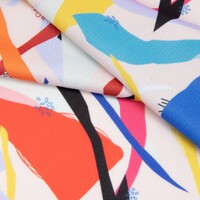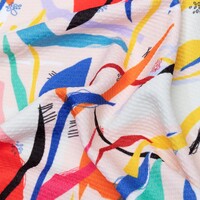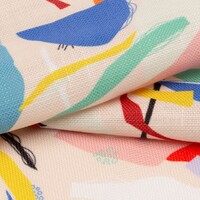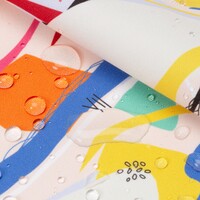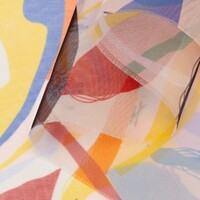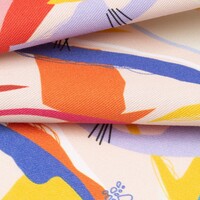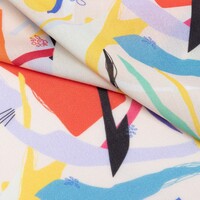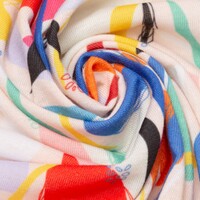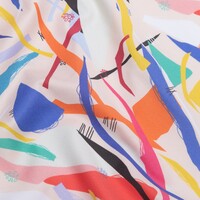Related:
Back to Site Stores ({{popupVm.storeTotalCount}})
Artists ({{popupVm.artistTotalCount}})
Perfect for hot weather and sportswear, print on demand breathable fabric is about to be your new best fri...
Read MoreShips In 1 - 2 days
Delivery: $12.95
Handmade
Need a specific dimension for your fabric? That's the beauty of print on demand breathable fabric.
Browse our range of breathable fabrics.
Medium weight, stiff and non-stretch with a matte finish
100% polyester
Medium weight, soft and stretchy with a matte finish
96% polyester, 4% elastane
Medium weight, soft and stretchy with a matte finish
100% polyester
Heavy weight, soft and stretchy with a matte finish
97% polyester, 3% elastane
Medium weight, stiff and non-stretch with a matte finish
100% polyester
Light weight, soft and stretchy with a matte finish
90% polyester, 10% elastane
Medium weight, smooth and non-stretch with a matte finish
100% polyester
Light weight, smooth and taut with a matte finish
100% Silk
Expected Shrinkage = Weft: 6% Warp: 9%
Lightweight, stiff and non-stretch with a matte finish
100% polyester
Heavy weight, soft and non-stretch with a matte finish
100% recycled polyester
Medium weight, soft and non-stretch with a matte finish
100% cotton
Medium weight, coarse and stretchy with a matte finish
95% polyester, 5% elastane
Medium weight, soft and stretchy with a smooth finish.
96% polyester, 4% elastane
Medium weight, soft and stretchy. Eyelet knit gives honeycomb surface effect.
100% polyester
Lightweight, quick-dry and stretchy with a pinhole finish
100% polyester
Heavyweight, stiff and with a matte finish
100% polyester
70% wool, 30% silk. Woven in Italy and finished in England. Light cream base color, open plain weave. An airy, light, flowing, soft yet strong quality, Suitable for scarves and fashion. Expect shrinkage 4% weft, 2% warp. Super bright colors and deep blacks using reactive ink chemistry.
70% wool, 30% silk
Expected Shrinkage = Weft: 5% Warp: 3.5%
100% pure Silk. 1.77 oz. Off white base color with a sparkle. Soft lightweight fine quality, with a crepe finish and light ribs in the weft. Airy, light, flowing, soft yet strong. Straddling the border between fashion and fashion accessories. Expect shrinkage 5% weft, 8% warp.
100% Silk
Expected Shrinkage = Weft: 5% Warp: 9%
70% cotton 30% silk lightweight woven voile. Print shows through 90% to reverse. Super bright colors & deep blacks using reactive ink chemistry.
70% cotton, 30% silk
Expected Shrinkage = Weft: 2% Warp: 1%
Floaty and buttery soft fabric with an elegant drape. Plain woven lightweight 100% viscose with slight stretch in the weft. Super bright colors & deep blacks when layered. Printed using reactive ink chemistry.
100% viscose
Expected Shrinkage = Weft: 5% Warp: 1%
Soft, Elastic, Matte, Opaque, Knitted, recycled Poly Jersey. Soft touch Jersey. Use: clothing, t-shirts. Polyester yarn made from 100% Post-consumer waste.
96% Recycled Polyester, 4% Elastane
325 thread count, high quality bedding material. 100% BCI cotton (Better Cotton Initiative) . Bright white base color, smooth luxury delicate yet durable material. 5-Star hotel bed linen quality. Wide width material at up to 69" print width.
100% cotton
Expected Shrinkage = Weft: 1% Warp: 1%
Medium weight 100% linen plain weave fabric. Contains characteristic slubs and bobbles, will include occasional unprinted white dots. Super bright colors & deep blacks using reactive ink chemistry. Uses: clothing, kitchen textiles, curtains, light upholstery.
100% linen
Expected Shrinkage = Weft: 5.8% Warp: 1.6%
Lightweight bright white cotton, with crisscross texture. Sharp and defined pigment print with bright colors and deep blacks, working well with the classic slub texture. Uses: Garments like shirts, dresses, light jackets, and homeware items such as tablecloths, napkins, tea towels, bedding.
100% cotton
Care instructions
Wash at 30°C / 86°F, low tumble dry heat, hang to dry, do not wring, low heat iron.




Breathable fabric is a material which has the ability to allow moisture vapor to be passed through it. This makes for great all-weather garments, and are among the best fabrics for sweating. There are two ways in which moisture can pass through a fabric. The most common is ventilation; this is where the fabric itself is porous, which allows the air to pass through - or vent - from it. If there are bigger and more holes (or pores) the textile will be more breathable than those with fewer or smaller pores. There are some non-porous fabrics which can be breathable materials, this type of material is often breathable waterproof fabric.
For a fabric to be noticeably breathable, there must be a difference in the air humidity on either side of the fabric, and water can move both directions through a textile. If - for example - you've been for a run, and it is 68% humidity inside your breathable shirt, but the humidity outside is only 25% because it is a warm, sunny day, then the water vapor inside your shirt will naturally want to pass through your breathable material to the outside. If the air humidity is 40% on both the inside and the outside of your shirt, it will still be breathable, however you won't notice it. If the air humidity on the outside of your shirt, is higher than that inside, then the water vapor will actually move inwards. This is not common and is more likely to be seen in places that are near coastal regions and close to the equator.
To use our print on demand service, just upload your design and choose your fabric. Tell us your dimensions and how you want your fabric finished, and we'll take it from there.
You have four edging options for your printed breathable fabric:
"As is" - we will send your fabric exactly as it comes from the digital printer, with an unprinted border around the edge of your design.
"Cut on The Line" - have one of our experts cut your print out, leaving no white edges on your breathable material
Hemmed - with a choice of an overlocked hem, or a baby hem. To create a hem on light weight material or medium weight fabrics that fray, we will make a two fold hem using a straight stitch. On heavy, stiff or no-fray fabrics, a single fold hem with a straight stitch is used.
Please ensure that you take the hem into account when selecting your custom sizes. For light fabrics, the hem will take up 0.23" - 0.31", on each of the 4 sides. On other fabrics, the hem will take up 0.59" - 0.78", on each of the 4 sides. You can choose either black or white thread for either of the hemming options.
Your custom breathable fabric is digitally printed using one of two methods: dye sublimation and pigment printing. Both of our expert methods will permanently bond your design to your chosen custom fabric, in full color. Pigment printing is mostly used in natural fabrics. It is a very localized printing method, which applies colored dyes directly to a part of the fabric, and builds up the design. Dye sublimation is a two step process, more frequently used with synthetic materials. It involves printing your design onto a transfer sheet and then using heat to bond this to the fabric.
All of our fabrics are printed at 200dpi. This works for us as it combines a great quality as well as a good file weight. In order to avoid resizing and interpolation, we recommend that you scale your image to 100% at 200dpi. Our design interface works with a traffic light system that acts as a quality marker for your designs. This will show you whether the resolution is too low for printing. When you re-upload your design with a highest resolution, the traffic lights will change color, showing you're good to go. A message will pop up alongside the traffic lights to let you know if the resolution is too low or if you have a good quality image.
Your uploaded design will automatically be scaled to fit the size of fabric you've chosen. You can change the dimensions of your fabric by amending the measurements on the ‘Product Options’ tab, under ‘Print Size’. To see how this fits with the dimensions of your image/design, you can refer to the ‘Images & Text Tools’ tab under 'Quality Information'. Here, you will be able to edit the dimensions of the image.
We always recommend using an RGB color space when you upload your images. More specifically, we suggest using the sRGB image profile, to achieve best color results. This will need to be done in your editing software; choose RGB as the working space, and assign the image profile as sRGB (full name sRGB IEC61966-2.1)
There is no length limit for most of our fabrics. Our preview design window is set up to displaying a maximum of 10m (32.8 ft) to help you visualize the print, but that doesn't mean this is the print limit. If you'd like to order more, you can increase the quantity (x2 for 20m or x4 for 40m for example) and order as much as you'd like. Larger volumes will receive an automatic discount too. While the fabric length is nothing to worry about, each individual fabric will have a maximum width side: These can be found on the fabric's page information or in the design interface.
Yes, that will help you when it comes to cutting or framing your printed fabric. We recommend always adding a little extra space for borders into your purchased fabric size. When we print your materials, or send out fabric samples, we typically trim squarely around the fabric, leaving approximately 5mm white space. Cutting neatly on the line has an additional fee.
Crocking is the term used to describe fading along the creases in a fabric. It typically can occur after constant washing or heavy use of digitally printed natural fabrics. Crocking can be minimized by hand washing your fabrics at a cooler temperature, rather than machine washing. If you want to make sure there's no chance of crocking, we'd suggest you use a poly fabric.
Yes, our organic fabrics don't have an additional coating like non-organic fabrics have, which means it absorbs the inks deep into its fiber and reducing the color strength slightly (this can be approximately -40%). If you would like a bolder, more vibrant color for your fabric, we would suggest using a non-organic fabric.
Unfortunately not; all of our fabrics have been tested meticulously to ensure we know exactly how to get the best results, and our facilities cater perfectly to them. If you are set on a fabric we don't offer, we can offer custom printed sublimation paper to order which will allow you to heat press your designs onto your own fabrics.
If your design is simple and less intricate, a JPEG will be absolutely fine. However, if you have created a design with multi-colored detailing, we would recommend saving your design in a TIFF format.
Similar to other fabric printing processes, shrinkage can occur. The amount of shrinkage will depend on the fabric, but as a general rule of thumb, please allow for 2-8% shrinkage when working out your measurements. Shrinkage is not an exact science, and the amount of shrinkage will vary from print run to print run. We'd always suggest order a little more than you need for your project.
Many of the fabrics we offer are semi-transparent, so printing on both sides of the fabric is not a service we offer.
At the moment, all of our fabric labels are printed on satin fabric. For now, we believe this is the best choice, but will potentially introduce other options in the future. All labels are cut to the same label format. If you would like to choose a different fabric and format for your labels, you could always order a sheet of the fabric of your choice to create labels yourself.
Our fabrics are printed with water-based inks as environmental consciousness is always front of our minds. Water-based inks include no chemicals or solvents, and our printing process uses heat to fix colors and patterns into place to avoid excess or contaminated water returning into the water system (this is something that can occur through steaming). All printing, fulfilment and production is done in our one facility, and rather than rolling the fabrics or sending them in a tube, you will receive your material folded up. This amounts to 150 tubes saved a week, as well as much more space on the delivery van for more orders. (For delicate fabrics we ensure to package appropriately).
Although very rare, there could be a slight color difference from one print run to another. This is a normal part of the printing process, however we are always working to improve our color profiles. It is unlikely that the difference in print runs will be hugely different (for example, it's unlikely your orange is suddenly going to be red). The likelihood of color variations can be intensified fabric to fabric due to materials having different grains and textures; natural fabrics typically have more muted color tones, while poly alternatives have a bolder hue. This is because the construction of the material is different, and the printing method has to be altered slightly for more delicate, natural textiles.
Our full cut & sew service at Bags of Love can be used to your full advantage. We even offer hemming for your fabrics at a small additional cost. Our hems are created with a one or two cold hem that typically uses around 5 to 20mm of fabric (depending on the thickness of your chosen material). Please bare this in mind when you are ordering your printed fabric with hems: If you would like your finished piece to be 40" x 40", change your dimensions to 41" instead to allow space for your hems (you will also need to include additional for potential shrinkage). The thicker the fabric, the bigger the hem will be. Your printed fabric will be hemmed with either Black or White thread. If you are ordering a lightly woven material or a printed silk, you will find that one hem will be straight, while the other slightly rippled. The hemming material allowances are as follows and you need to make your print bigger to accommodate the hem:
For further information about our fabrics see our FAQs.
Please note: As everything we provide is handmade to order, you may find a slight variance in the sizes.


